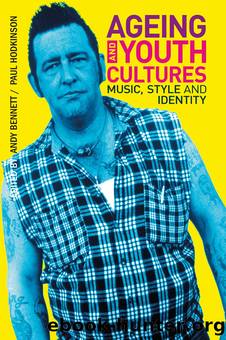Ageing and Youth Cultures by Hodkinson Paul; Bennett Andy; & Paul Hodkinson

Author:Hodkinson, Paul; Bennett, Andy; & Paul Hodkinson
Language: eng
Format: epub
Publisher: Bloomsbury Publishing Plc
Published: 2013-04-26T16:00:00+00:00
Neil then went on to offer some candid observations on the difficult process of managing an ageing body in the context of a scene that places a high level of emphasis on physical exertion over long periods of time and during hours that normally would be spent sleeping. In talking about the extreme physical demands that his lifestyle placed upon him (particularly during the summer months, when he may be involved in the organization of several parties each month), and how these increased as he grew older, Neil described the strategy he had adopted for coping with this:
Youâre stayinâ awake all Saturday night and then gettingâ to bed, say midday Sunday. I might have four hoursâ sleep, wake up, âave something to eat and then go back to bed again. Try to get ready for Monday morninâ. Anâ youâre just knackered really, so Monday can be a bit rough. So you âave an early night Monday to make up them two or three hours that you didnât get on Saturday night.
Accounts such as these are noticeably out of step with descriptions of the dance party scene that portray it as a space exclusively reserved for the exertion of youthful energy buoyed up by a âtwenty-four-hourâ party lifestyle. Rather, it brings a new dimension to our understanding of the contemporary dance party scene and those involved in it. Assuming the ârightnessâ and ânaturalnessâ of taking their lifestyle preferences forward with them into middle age, both of the ageing dance party participants discussed above show themselves to be confronted with a common challenge: how to adapt to the demands of the dance and party scene with an ageing body and the added responsibilities that age has brought with it.
Dance Parties as Family Outings
Another significant insight arising from interviews conducted with ageing dance party participants was the increasing tolerance towards the inclusion of families and children within the dance party scene. As original members of the 1980s Free Party scene have aged and the scene has diversified into a number of smallerâin many cases localizedâsubscenes, family involvement is becoming an increasingly normalized aspect of the dance party experience. This was evident in accounts offered by members of a small, close-knit dance collective based in the southeast of England that exhibited something of an open-door policy regarding the inclusion of children. In addition to being a necessary organizational element in the staging of dance parties for and by people who wished to involve their families, this informally observed policy of inclusivity was also considered highly desirable when contrasted with what was considered an overtly inscribed exclusivity among more youth-centred scenes. As one of the principal organizers involved in the collective explained:
[A lot of] youth cultures focus on a particular genre to exclude other people. Hip hop is a classic example because itâs quite narrowly defined [and] the hip hop guys listen to a specific type of hip hop and they all dress in a certain way, anâ itâs their scene. Whereas with ours, itâs
Download
This site does not store any files on its server. We only index and link to content provided by other sites. Please contact the content providers to delete copyright contents if any and email us, we'll remove relevant links or contents immediately.
| Anthropology | Archaeology |
| Philosophy | Politics & Government |
| Social Sciences | Sociology |
| Women's Studies |
Born to Run: by Christopher McDougall(6908)
The Leavers by Lisa Ko(6815)
iGen by Jean M. Twenge(5184)
Sapiens by Yuval Noah Harari(5135)
The Kite Runner by Khaled Hosseini(4971)
Spare by Prince Harry The Duke of Sussex(4811)
Bullshit Jobs by David Graeber(3857)
Machine Learning at Scale with H2O by Gregory Keys | David Whiting(3684)
Never by Ken Follett(3559)
Livewired by David Eagleman(3545)
Goodbye Paradise(3471)
Fairy Tale by Stephen King(2989)
A Dictionary of Sociology by Unknown(2866)
Harry Potter 4 - Harry Potter and The Goblet of Fire by J.K.Rowling(2830)
The Social Psychology of Inequality by Unknown(2780)
The Club by A.L. Brooks(2762)
0041152001443424520 .pdf by Unknown(2637)
People of the Earth: An Introduction to World Prehistory by Dr. Brian Fagan & Nadia Durrani(2627)
Will by Will Smith(2607)
